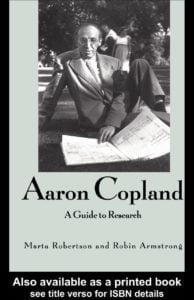Browse in the Library:
Aaron Copland – Piano Fantasy with sheet music

At just over half-an-hour in duration, this is among Copland’s most ambitious works in any genre, and the single-movement format places notable demands on the performer’s stamina as well as on the listener’s concentration. Serial procedures are freely employed, such that the overall feel is discernibly, though far from ‘classic-ally’ tonal.
The opening features a ten-note scale (four descending and six ascending notes) that, along with the two omitted notes of the chromatic scale which act as a punctuating cadence, forms the motivic nucleus of the whole piece. The first part of what is effectively a three-part design continues with a more lyrical section, then a fast toccata-like passage, which itself is rounded off by a tranquil pastorale.
The second part is an extensive scherzo, of a rhythmic fluidity which recalls Copland’s music of the early 1930s, and with a central trio whose playfulness disguises some exacting interplay between the two hands. A varied recall of the scherzo music leads straight into the work’s dynamic and emotional apex, following which, the third part returns to the material of the first in a far from literal reprise. A quiet coda then touches on aspects of the initial scale, before reaching a calm and fulfilled close.
Aaron Copland about the Piano Fantasy
Fantasy for Piano
By AARON COPLAND
My Piano Fantasy, completed in January of this year, is a large-scale work in one movement, lasting half an hour in performance. A long and continuous one-movement form has always seemed to me one of the most taxing assignments a composer can undertake. The word assignments, perhaps ill-chosen, since this particular task was self-imposed.
My idea was to attempt a composition that would suggest the quality of fantasy, that is, a spontaneous and unpremeditated sequence of “events” that would carry the listener irresistibly (if possible) from first note to last, while at the same time exemplifying clear if somewhat unconventional structural principles.
“The spontaneous,” says Paul Valery, “is the fruit of conquest.” It implies a creator who can “keep the unity of a work’s ensemble while realizing the separate parts, and without losing its spirit or nature on the way.” To give free rein to the imagination without loss of coherence — to be “fantastic” without losing one’s bearings, is venturesome, to say the least.
And yet, a work of art seems to me the ideal proving ground for just such a venture. At any rate, my Piano Fantasy is such a venture.
Like my two previous extended works for solo piano, the Piano Variations (1930) and the Piano Sonata (1939-41), the new work belongs in the category of absolute music. It makes no use whatever of folk or popular musical materials.
I stress this point because of a tendency in recent years to typecast me as primarily a purveyor of Americana in music. Commentators have remarked upon my “simplicity of style” and my “audience appeal” in such a way as to suggest that that is the whole story, and the best of the story.
As a matter of fact, a composer in our time is comparatively helpless as to the picture of himself that will be presented to the listening public. Commercial exploitation of serious music, even contemporary serious music, is by definition plugging the “well-known.”
By and large, performances are restricted to a narrow list of one’s more accessible works, and this restriction often obtains in concert and broadcast performances. I do not mean to belittle the value of accessibility, nor the value for native music of a certain Americanism in our musical language. But neither do I wish to be limited to that frame of reference. In my own case a rounded picture would have to take into account works like my Piano Quartet and Piano Fantasy.
The musical framework of the entire Piano Fantasy derives from a sequence of ten different tones of the chromatic scale. To these are subsequently joined the unused two tones of the scale, treated throughout as a kind of cadential interval. (In fact, a good case could be made for the view that the over-all tonal orientation is that of E major.) Thus, inherent in the materials are elements able to be associated with the twelve-tone method and with music tonally conceived.
To describe a composer as a twelve-toner these days is much too vague. Too many composers in too many countries have been making too varied a use of dodecaphonic techniques to justify so simple a label. My own Fantasy, for example, is by no means rigorously controlled twelve-tone music, but it does make liberal use of devices associated with that technique.
As I see it, twelve-tonism is nothing more than an angle of vision. Like fugal treatment, it is a stimulus that enlivens musical thinking, especially when applied to a series of tones that lend themselves to that treatment. It is a method, not a style; and therefore it solves no problems of musical expressivity.
As a method, it seems nowadays to be pointing in two opposite directions: toward the extreme of “total organization” with its concomitant electronic applications, and toward a gradual absorption into what has become a very freely interpreted tonalism.
But these are preoccupations of the musical kitchen; audiences have other things to think of, things that are more fundamental to the expressive content of the piece. Is the Fantasy a large and free utterance, serious and thought-provoking? From my standpoint, that is the more absorbing question.
The Piano Fantasy was commissioned by the Juilliard School of Music as part of its fiftieth anniversary celebration. Because the work was not ready in time for performance, as originally planned, at the special series of concerts held in February 1956, to memorialize that event, the Juilliard administration has arranged a special concert for its presentation on Friday.
